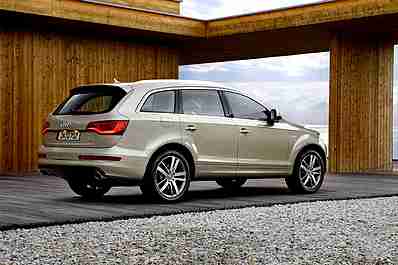 It sets standards in its class with efficient engines and a
standard eight-speed tiptronic transmission. It sets standards in its class with efficient engines and a
standard eight-speed tiptronic transmission.
Body and interior
The design of the Audi Q7 exudes performance and presence. The hood, the
front fenders, and the wrap-around rear hatch are aluminum. Add-on parts
come standard in a contrasting color, with an option for parts in the body
color with chrome trim. All Audi Q7 models roll off the assembly line with
the high-gloss package; other interior design packages are available as options.
Thanks to its 3.00 meter (9.84 ft) wheelbase, the 5.09 meter (16.70 ft) long
Q7 has interior room to spare. 27 different seating configurations are possible.
The large SUV is available as a five-, six- or seven-seater, with a choice
of either individual deluxe seats or a variable bench seat in the second
row and an optional third row. The seat backs in the second row can be folded,
increasing the cargo capacity from a volume of 775 liters (27.37 cubic ft)
to 2,035 liters (71.87 cubic ft). Three different types of seats are available
for the driver and the front-seat passenger, topped by climate-controlled
comfort seats that can be heated and ventilated. With its elegant lines and
many upscale details, the interior conveys the typical Audi wellness feeling.
The fit and finish knows no compromise.
Drivetrain
The Audi Q7 engine lineup features six engines with six or eight cylinders.
The two three-liter gasoline engines – supercharged V6 units with different
power ratings – and the V6 TDI are characterized by groundbreaking
efficiency. The V8 diesel offers an impressive 800 Nm (590.05 lb-ft) of torque.
A recuperation system is standard; the 3.0 TDI also features a start-stop
system and sophisticated thermal management.
The most efficient engine in the Q7 is the V6 diesel with 150 kW (204 hp),
which consumes an average of just 7.2 liters of diesel per 100 km (32.67
US mpg). Audi offers a particularly low-emission clean diesel model with
the Audi 3.0 TDI with 180 kW (245 hp). Complex technology is used here to
minimize NOx emissions. The start-stop system reduces fuel consumption.
The engines:
-
3.0 TFSI quattro with 200 kW (272 hp)
-
3.0 TFSI quattro with 245 kW (333 hp)
-
3.0 TDI quattro with 150 kW (204 hp)
-
3.0 TDI quattro with 180 kW (245 hp)
-
3.0 TDI clean diesel quattro with 180 kW (245 hp)
-
4.2 TDI quattro with 250 kW (143 hp)
All of the engines deliver their power to the quattro permanent all-wheel
drive via a newly developed eight-speed tiptronic. With its wide spread and
long-ratio upper gears, the automatic transmission also makes an important
contribution to high efficiency.
Chassis
The Audi Q7 has a sophisticated chassis. Aluminum double wishbones mounted
on subframes guide the wheels. The optional adaptive air suspension (standard
in the Q7 4.2 TDI) with electronic damper control varies the ground clearance
depending on the situation. The driver can choose from five characteristics
using the MMI operating system. Wheels range from 18 to 21 inches in diameter.
Large, internally ventilated disc brakes provide the stopping power. Huge
discs in lightweight carbon fiber-ceramic are optionally available for models
with the two most powerful engines. The ESP stabilization program includes
an offroad mode. A hill descent assist engages when going downhill offroad.
Equipment and trim
 Among the standard features in the Audi Q7 are
a two-zone, automatic air conditioning system, a high-beam assistant and
the MMI radio operating system. A power rear hatch (standard in the Q7 4.2
TDI) and a rail-based load securing set for baggage are available for sports,
recreation and vacation travel. Audi offers an entire system of infotainment
modules. Among the standard features in the Audi Q7 are
a two-zone, automatic air conditioning system, a high-beam assistant and
the MMI radio operating system. A power rear hatch (standard in the Q7 4.2
TDI) and a rail-based load securing set for baggage are available for sports,
recreation and vacation travel. Audi offers an entire system of infotainment
modules.
The top-of-the-line version integrates a hard disk drive for
navigation, music, and telephone data; a color monitor with 3D graphics;
a DVD player; and voice control.
A special highlight is the 1,000 watt Bang & Olufsen sound
system with 14 speakers. Advanced assistance systems round out the list of
options. |

